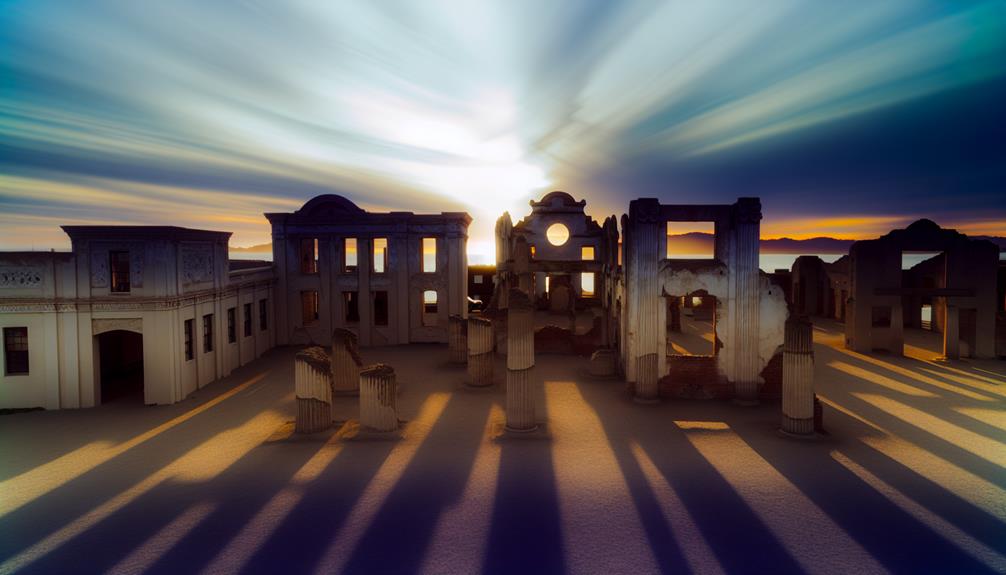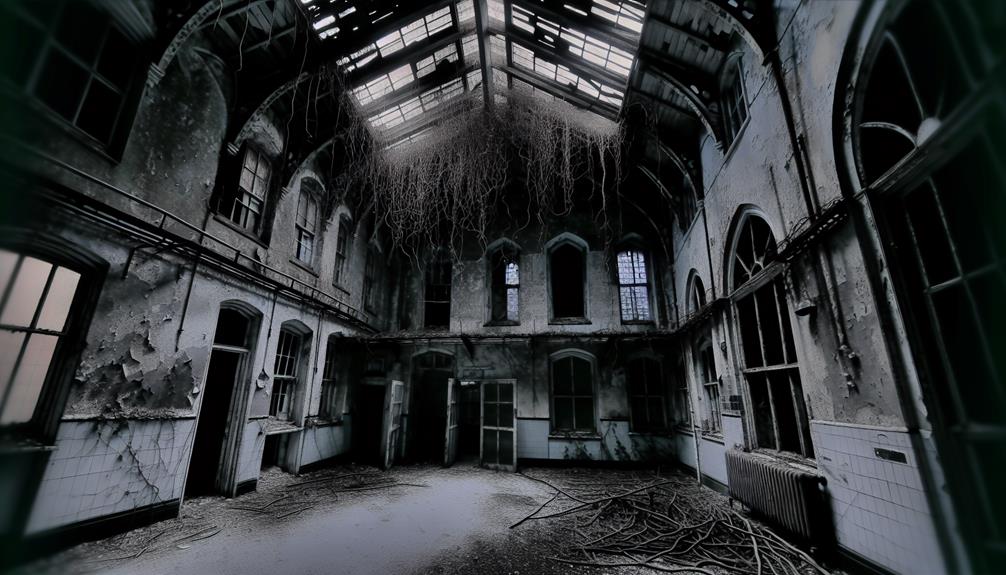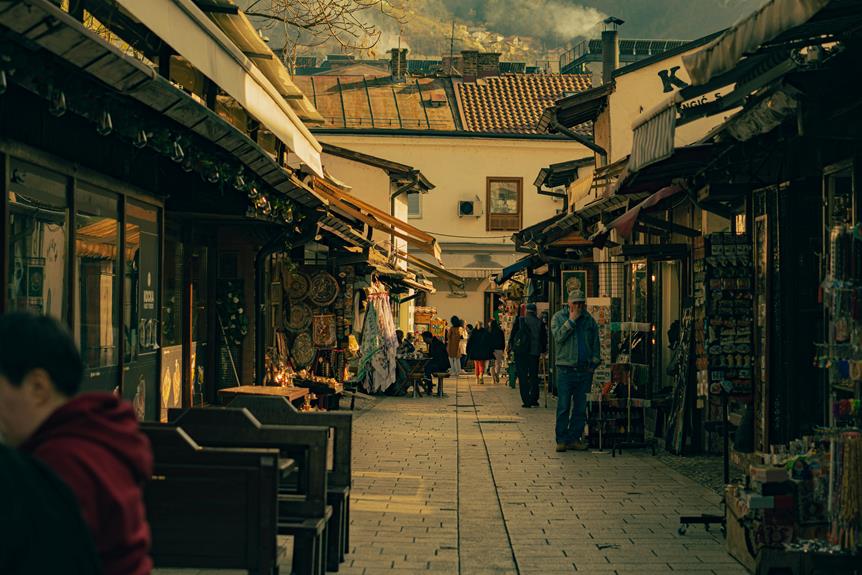Exploring the historic San Francisco earthquake sites offers a unique opportunity to witness the lasting impact of a defining moment in the city's history. From the remnants of the Great 1906 Earthquake to the solemn grounds of Mission Dolores Cemetery, each location holds a piece of the past waiting to be uncovered. As visitors traverse through these sites, they are transported back in time, connecting with the resilience of a community that faced adversity head-on. Join us as we investigate the echoes of the past, unraveling the stories and lessons hidden within the historic San Francisco earthquake sites.
Key Takeaways
- Gain insight into the 1906 earthquake impact and rebuilding efforts.
- Visit Mission Dolores Cemetery for historical significance and preservation efforts.
- Explore Fort Point National Historic Site for military architecture and defense history.
- Immerse in Chinatown to understand Chinese immigrant struggles and triumphs.
- Experience the Palace Hotel Ruins to witness early 20th-century architectural techniques.
The Great 1906 Earthquake Site
The Great 1906 Earthquake site is a significant historical landmark in San Francisco, marking the devastating impact of one of the most powerful earthquakes in California's history. This seismic event, which occurred on April 18, 1906, with an estimated magnitude of 7.9, caused widespread destruction throughout the city, leading to fires that raged for days and left approximately 3,000 people dead and over 80% of the city in ruins.
Following the earthquake, extensive rebuilding efforts were undertaken to restore San Francisco to its former glory. The seismic impact of the 1906 earthquake led to advancements in building codes and earthquake engineering, shaping the way structures were constructed in earthquake-prone regions. The disaster highlighted the importance of preparedness and resilience in the face of natural disasters, influencing urban planning and disaster response strategies for years to come.
Visiting the Great 1906 Earthquake site offers a somber reminder of the city's tumultuous past and the resilience of its residents in the aftermath of such a catastrophic event. The site serves as a poignant reminder of the fragility of human civilization in the face of nature's forces and stands as a reflection of the enduring spirit of San Francisco and its ongoing commitment to seismic safety.
Visiting Mission Dolores Cemetery
Nestled in the heart of San Francisco, Mission Dolores Cemetery beckons visitors with its storied past and tranquil surroundings. As one of the oldest cemeteries in San Francisco, Mission Dolores holds a significant place in the city's history. Established in 1776, this burial ground is the final resting place for many early settlers, Native Americans, and prominent figures from the Spanish colonial period.
The Mission Dolores Cemetery is not only a place of remembrance but also a reflection of the city's diverse cultural heritage. Walking through the cemetery, visitors can observe the different styles of headstones and markers that represent various traditions and beliefs. The peaceful atmosphere invites contemplation and reflection, offering a sense of connection to the past.
One of the most notable aspects of Mission Dolores Cemetery is its association with the devastating 1906 earthquake. The earthquake caused significant damage to the cemetery, with many graves being disrupted and monuments destroyed. Despite the destruction, efforts were made to restore and preserve this historic site, making it a poignant reminder of the city's resilience in the face of tragedy.
Visiting Mission Dolores Cemetery provides a unique opportunity to pay homage to the early inhabitants of San Francisco and gain a deeper understanding of the city's rich history. Whether seeking solace, historical insight, or simply a moment of quiet contemplation, this burial ground offers a profound experience for those who wish to connect with the past.
Exploring Fort Point National Historic Site
Located at the foot of the Golden Gate Bridge, Fort Point National Historic Site serves as a reminder of the strategic military history of San Francisco. The site showcases impressive military architecture and played an essential role in coastal defense during various periods of American history.
Key Features of Fort Point National Historic Site:
- Strategic Location: Situated at the entrance to San Francisco Bay, Fort Point's location was crucial for protecting the city from potential naval threats.
- Military Architecture: The fort's design, characterized by its formidable walls and casemates, reflects the military engineering practices of the mid-19th century.
- Coastal Defense Significance: Fort Point's strategic position allowed it to serve as a deterrent against enemy attacks on the West Coast, highlighting its importance in coastal defense strategies.
Exploring Fort Point National Historic Site provides visitors with a glimpse into the past, offering insights into the military strategies and technologies employed to safeguard the San Francisco Bay area. The site's historical significance lies not only in its architectural marvel but also in its role as a symbol of the nation's commitment to defending its coastal territories. Visitors can immerse themselves in the history of military defense while enjoying panoramic views of the iconic Golden Gate Bridge, making Fort Point an essential destination for history enthusiasts and admirers of military heritage.
Walking Through Chinatown's History
Immerse yourself in the rich cultural tapestry of San Francisco by delving into the historical narrative of Chinatown's evolution. Chinatown stands as a tribute to the enduring spirit of Chinese immigrants who flocked to San Francisco during the 19th century. These immigrants played a pivotal role in shaping the city's identity, contributing to its economic growth and cultural diversity. As you walk through the bustling streets of Chinatown, you can almost feel the echoes of the past resonating through its narrow alleyways and ornate buildings.
The cultural preservation efforts in Chinatown have been instrumental in safeguarding its heritage. From traditional Chinese architecture to vibrant festivals and authentic cuisine, every aspect of Chinatown reflects a deep-rooted commitment to honoring its past. The ornamental gates, adorned with intricate designs and mythical creatures, serve as a symbolic entry point into a world where tradition meets modernity.
Exploring Chinatown offers a glimpse into the struggles and triumphs of Chinese immigrants who sought a better life in America. The stories etched in the walls of temples and community centers speak of resilience and perseverance in the face of adversity. By immersing yourself in Chinatown's history, you not only gain a deeper appreciation for its cultural significance but also become a part of its ongoing narrative of resilience and cultural pride.
Discovering the Palace Hotel Ruins
The remnants of the once-grand Palace Hotel provide a somber yet intriguing glimpse into San Francisco's tumultuous past. The Palace Hotel, once a symbol of luxury and elegance in the heart of the city, now stands as a haunting reminder of the devastation caused by the 1906 earthquake.
- Historic Preservation: Efforts have been made to preserve the ruins of the Palace Hotel as a tribute to the city's resilience and history. By maintaining the site, future generations can understand the impact of the earthquake and appreciate the architectural significance of the building.
- Architectural Significance: The Palace Hotel was renowned for its grandeur and innovative design at the time of its construction. Studying the ruins provides insight into the architectural techniques used in the early 20th century and the evolution of building practices in response to seismic events.
- Ruins Exploration: Visitors can explore the remains of the Palace Hotel, witnessing firsthand the structural damage caused by the earthquake and subsequent fires. Walking through the ruins offers a unique opportunity to connect with the past and reflect on the resilience of the city and its inhabitants.
The Palace Hotel ruins serve as a poignant reminder of San Francisco's history, highlighting the importance of historic preservation and the enduring legacy of architectural marvels even in the face of natural disasters.
Remembering the Fire of 1906
The inferno that engulfed San Francisco in 1906, following the devastating earthquake, left an indelible mark on the city's landscape and collective memory. The fire aftermath was as catastrophic as the quake itself, with raging flames spreading rapidly due to ruptured gas lines and a lack of water to combat the blaze. The flames devoured almost 30,000 structures across 520 blocks, leaving over 200,000 residents homeless and the once-thriving city in ruins.
In the wake of the destruction, San Franciscans displayed remarkable resilience and unity in their efforts to rebuild. The city swiftly initiated extensive rebuilding efforts, which saw the emergence of innovative architectural designs and the introduction of stricter building codes to prevent such widespread devastation in the future. The reconstruction process was not merely about physical structures but also about restoring hope and the spirit of the city.
Today, reminders of the fire of 1906 can still be found in San Francisco's urban fabric. From commemorative plaques marking the sites of significant buildings to stories passed down through generations, the memory of the inferno continues to resonate. Visiting these sites allows us to pay homage to the resilience of the city and its inhabitants, ensuring that the lessons learned from the fire of 1906 are never forgotten.
Frequently Asked Questions
Are There Any Paranormal Activities Reported at the Great 1906 Earthquake Site?
Ghost sightings and paranormal investigations have been reported at the Great 1906 Earthquake site in San Francisco. Visitors have claimed to witness historic hauntings and supernatural occurrences, with some reporting eerie experiences and unexplained phenomena.
The area's tragic history and the significant loss of life during the earthquake have contributed to the belief that spirits may still linger in the vicinity, making it a popular destination for those intrigued by the supernatural.
Can Visitors Access Any Restricted Areas at Fort Point National Historic Site?
Exploring ruins at Fort Point National Historic Site offers a glimpse into the past, but visitor restrictions are in place to guarantee safety and preservation. Access to certain areas is limited to safeguard the historical integrity of the site.
Are There Any Guided Tours Available for Exploring Chinatown's History?
Are there any guided tours available for exploring Chinatown's history?
Engage in the rich tapestry of Chinatown's past through walking tours that offer cultural exploration. Discover the intricate history behind this iconic neighborhood as knowledgeable guides lead you through its vibrant streets, sharing stories of resilience and heritage.
Immerse yourself in the sights and sounds of Chinatown, experiencing a deeper connection to this historical gem.
Can Visitors Still Stay Overnight at the Palace Hotel Ruins?
Visitors are unable to stay overnight at the Palace Hotel ruins due to historical preservation efforts.
The ruins of the Palace Hotel represent a significant piece of San Francisco's history and are currently undergoing restoration to preserve their architectural and cultural value.
While overnight accommodations are not available at present, the restoration project aims to guarantee that future generations can appreciate and learn from this iconic site's rich heritage.
What Efforts Have Been Made to Prevent Another Fire Disaster in San Francisco?
Efforts to prevent another fire disaster in San Francisco have been noteworthy. City planning initiatives focus on implementing thorough building codes, ensuring fire-resistant materials are used in construction, and enhancing emergency response capabilities.
In addition, public awareness campaigns educate residents on fire safety measures. Collaborations between city officials, fire departments, and urban planners have led to the development of thorough strategies to mitigate fire risks and safeguard the city against potential disasters.
Conclusion
To sum up, touring the historic San Francisco earthquake sites offers a poignant portrayal of the city's resilience and spirit. These locations provide a unique insight into the devastation and rebuilding efforts following the 1906 earthquake.
Visitors can pay homage to the lives lost and gain a deeper understanding of San Francisco's history. The echoes of the past found in these sites serve as a powerful reminder of the enduring strength of the city and the importance of preserving its memory.


